The Templestay Evoking Memories of Mountains
Christian Couple Park Mi-gyeong and Kang Hui-bok
Text by. Park Hyeon-suk Photo by. Hyeon Jin
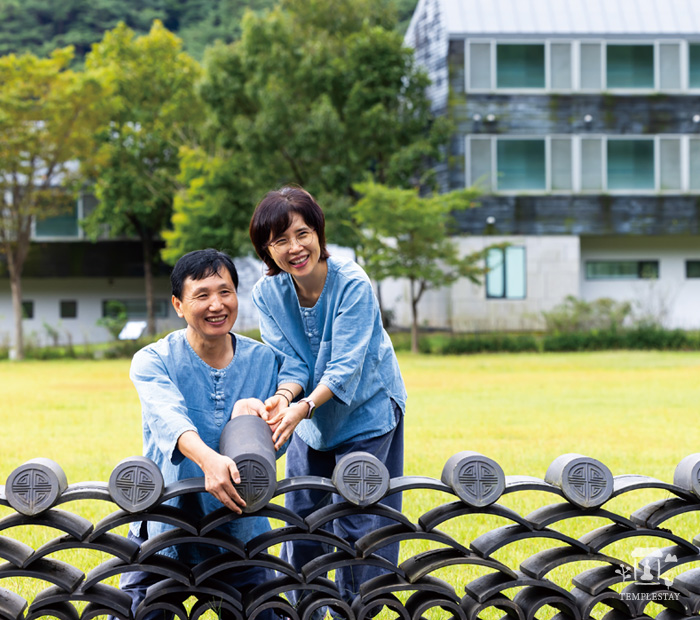
Starting with a Sudeoksa Templestay in 2016, Park Mi-gyeong has since visited 25 temples to participate in Templestay. Templestays remind her of the mountains she has loved all her life. As she climbs any mountain trail, she is always moved by the clean air, the sounds of nature, and the ever-changing scenery. And when she finally reaches the top of the mountain, she is presented with a view she could not have imagined from the bottom of the mountain. The process of climbing a mountain is also similar to a Templestay. At the beginning of fall, Ms. Park went on a Templestay with her husband, Kang Hui-bok, now like a lifelong dharma friend, to the Korean Culture Training Institute in Gongju.
Buddhism teaches us that even a fleeting encounter is not something to take for granted. Even simply brushing past a person could be from a karmic tie that began eons ago. These ties can be based in both direct and internal causes, and the external conditions or circumstances that initiated those causes. If causes are seeds, the environment we are in can be likened to soil, rain, and sunlight, elements that create the conditions. The first meeting between a girl from Seoul, Park Mi-gyeong, and a bachelor from Buyeo, Kang Hui-bok, took place over 30 years ago and illustrates the mysterious beauty of karmic ties.
That Day, That Bus, That Person, That Conversation, That Bond
Ms. Park had come to Buyeo to visit her maternal grandparents and was returning home to Seoul. Mr. Kang was on his way from Buyeo (his hometown) to Seoul and was assigned a seat next to Ms. Park on an intercity bus from Buyeo. The two were the same age, communicated well, and felt a mutual attraction. They got married after dating for two years. That day, that bus, that person, that conversation, that bond. They got along well, and the power of karmic ties was fulfilled.
Ms. Park recounts: “I’ve been married for 34 years already. I became a wife, mother of three, and worked as a civil servant. I also took care of my mother-inlaw for 27 years. Actually, I received more help from her than I gave. My motherin-law moved in with us to help raise our children. Our house was always bustling.
My in-laws and my nieces/nephews would often come to visit, and not just during school vacations. I worked hard to take care of the children and diligently prepared food for them. Even in the midst of all that, I continued to go hiking. I’ve always loved the mountains. I would carry my younger child on my back and climb while holding my older child’s hand.”
From a Heart that Wants to Be Loved to a Heart that Loves
Ms. Park, a loving and faithful wife, was struck by tragedy about 10 years ago. Her mother-in-law became ill and had difficulty moving, and her younger brother was diagnosed with cancer. He passed away six months before her mother-in-law.
The caregiver who took care of her mother-in-law with her advised her to rest, as she was exhausted both mentally and physically. Ms. Park considered going for a Templestay, and the first temple she visited was Sudeoksa Temple in 2016.
She says: “I had the opportunity to see myself through the practice of Seon meditation at dawn. It was a precious time to focus on myself, something I had not done for a long while. After that, whenever I had the chance, I went on a Templestay. It allowed me to disconnect from all the obligations I felt bound by in daily life and reflect only on myself.”
Today, Ms. Park, who has now done 29 Templestays at 25 temples, came to the Korea Culture Training Center at the foot of Mt. Taehwasan in Sagok-myeon, Gongju, Chungcheongnam-do, for yet another Templestay. All the temples she visited previously were places that preserved the original beauty of old temples, but this training center interprets traditional Korean architecture in a modern way. It embodies the spirit of Seung Hyo-sang, an architect who pursued the so-called “aesthetics of the poor” by emphasizing moderation and frugality in his architectural designs. Magoksa Temple is a 7-minute walk from the Korea Culture Training Center, allowing one to experience the unique pleasure of walking through the present and the past at the same time. On the way to Magoksa Temple, while listening to the relaxing sound of the stream flowing around the training center, Mr. Kang blushed shyly and said, “My wife retired from her civil service job last year and entered nursing school this year. At the age of 59, she ranked 4th out of 150 students!” Ms. Park had previously studied to become a nursing assistant and social worker, and had obtained a license to help her beloved family members who were suffering from illness. She now wants to become a hospice nurse to stay by the side of patients who are dying. It was a change brought about by the power of a “loving heart” that was hindered by a “desire to be loved.”
Ms. Park said: “While doing multiple Templestays, I became interested in Buddhism and started studying the mind. I went to a lay Buddhist college and took a sutra study course at the Jungto Society for two years.
While studying, I realized my heart wanted to be loved. My heart was dependent on the compliments of those around me and I didn’t know it was being poisoned. I was always anxious because I wanted to be loved. When I let go of the sense of duty that weighed down my heart like a heavy burden, and opened my heart to freedom, I was able to feel the sincerity of others that I hadn’t felt before. I thought they would be upset about the changes in me, but contrary to my expectations, our relationships became more sincere.”
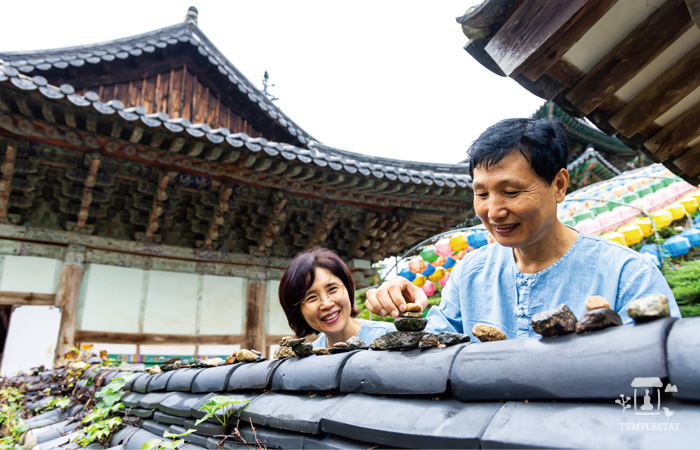
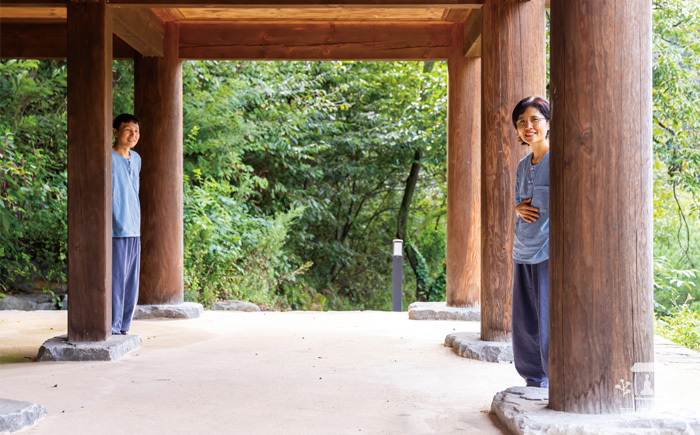
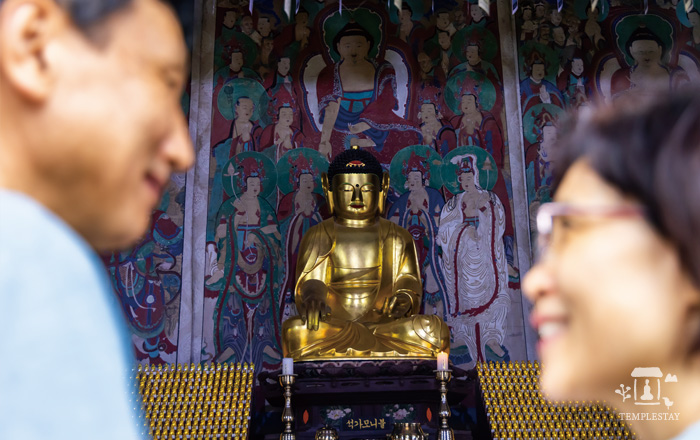
Another Mountain, Another Templestay
We arrived at Magoksa Temple as I listened to her stories of inner growth, stories I hope to remember a long time. The heavy rain that had been falling in the morning had turned into a light drizzle by noon, dampening the temple grounds. We visited Daegwangbojeon Hall, where a statue of Vairocana Buddha, the embodiment of Buddhist truth, is enshrined, and offered three prostrations. Nowadays, it is common even for adults to bow when greeting others by bending forward slightly at the waist, but in the past, people would prostrate themselves on the floor when greeting seniors; contemporaries would prostrate to each other.
Ms. Park added that she has fond memories of her mother-in-law, who would gently correct her when she bowed to the elders of the family, saying, “Honey, you should greet them properly.” Ms. Park finds the Korean tradition of greeting others by humbling oneself beautiful, which is also in line with Buddhist etiquette. A smile spread across her face as she stepped onto the wooden floor of the dharma hall, made from the planks of old trees. The wooden floors in dharma halls are something Ms. Park particularly likes. She says when she steps onto the cool wood in the pre-dawn hours, her mind snaps to life.
“I’m a Christian, but I didn’t feel uncomfortable with Buddhism while doing Templestays at various temples. Rather, I was moved when I learned new things.
I was also touched when I learned that the sound of the Buddhist dharma instruments, which I considered just noise before, symbolized compassion for all living beings.”
Templestays remind her of the mountains she loves. Although mountains may look similar, no two are the same. And just as each mountain evokes in her different emotions, temples do the same thing. Through almost all of the Templestay programs she experienced, she rediscovered the value of life and developed the power to heal herself. These programs included: the morning and evening ceremonies, practicing the 108 prostrations, making lotus lanterns, listening to the four dharma instruments, leisurely meditative walks, communal work, and conversing with monks over tea.
Ms. Park said, “I think the charm of Templestay is that you can feel at ease even while doing nothing. Previously, I did a rest-oriented Templestay at Cheoneunsa Temple with my devout Christian siblings. The accommodations were great and gave me the feeling of staying in a hanok (traditional Korean house). The beautiful scenery of Mt. Jirisan and the trail around the temple were also fantastic. I vividly remember the calm peace I felt there while chatting and walking with my siblings.”
After visiting Magoksa Temple’s five-story stone pagoda and its two-story Daeungjeon Hall, both still well-preserved over time, the couple had their National Heritage Visit Course Commemorative booklet stamped at the temple entrance.
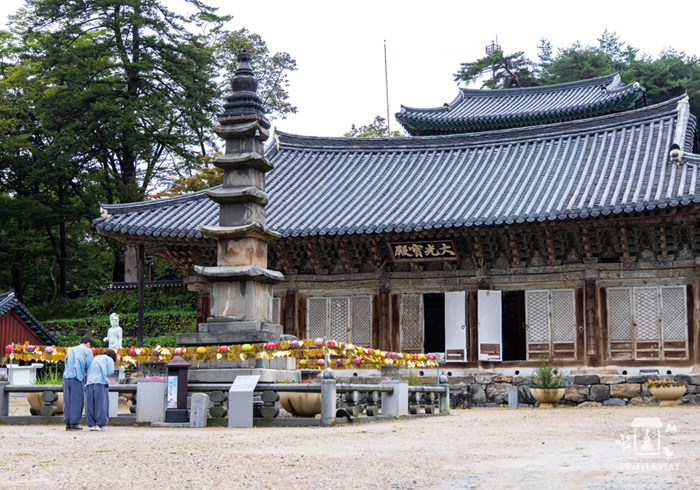
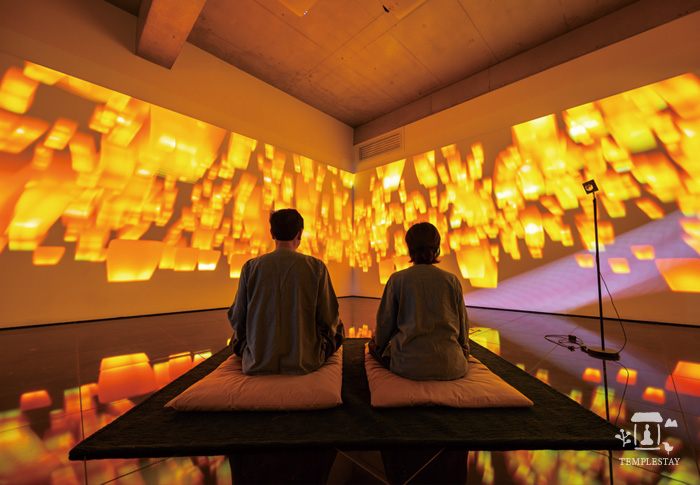
Tanks Are Not Afraid of Pebbles
As if in a time machine, we returned from the 1,000-year-old temple Magoksa to the modern Korean Culture Training Center. The training center is located on a site where 56 large tile kiln ruins were discovered when it was built in 2005. The Korean Roof Tile Museum is also located there. After touring the museum, where we learned about the production and distribution of tiles in the Magoksa area, we meditated in a unique “Secret Room,” where fantastic digital images unfold on all sides. Afterward, we went to a building that looked like a small movie theater.
The couple tried posing like movie characters in the “Healing Forest,” where they could become reinspired while watching images of tiles and nature projected on a large screen. Mt. Kang said, “It feels like we’re on our honeymoon again and taking pictures!”
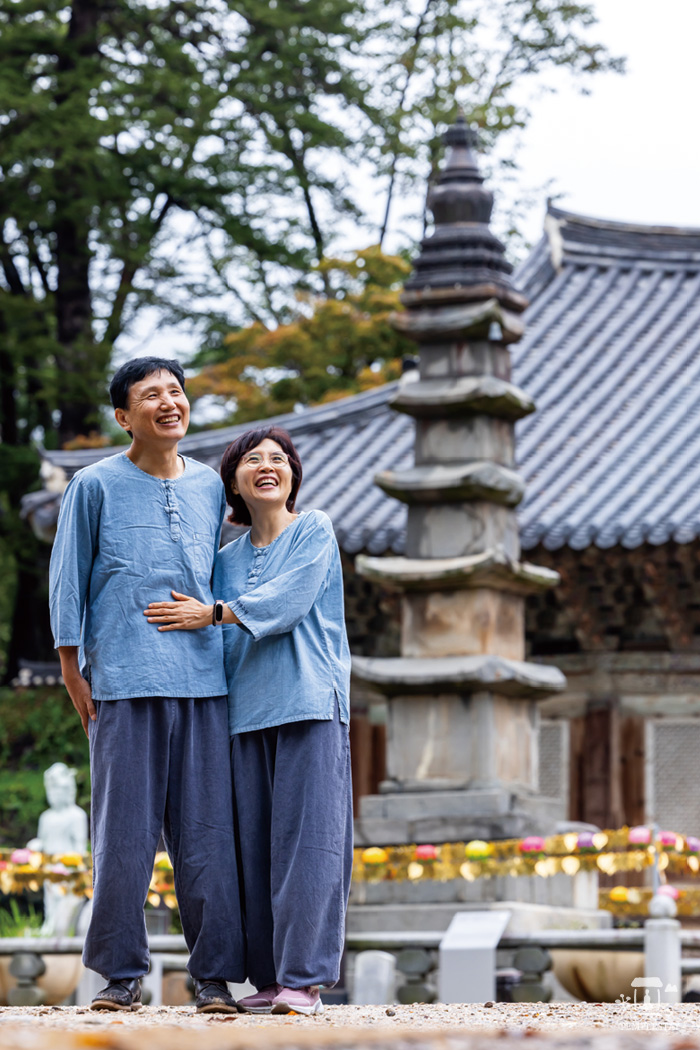
The next morning, the couple said they felt the approaching autumn as they looked at the vast blue sky and the wide lawn full of life energy. They also noticed the roof tiles that protect the building. They are different from each other (like the two halves of the yin-yang symbol), but they lie harmoniously side-by-side, inspiring the couple to ponder the true meaning of the word “couple.”
Together, we headed to the Hanok Experience Center, our ankles getting wet from the morning dew that still clung to the grass. Ven. Geumo, head of the Korean Culture Training Center, offered us tea. With his unique sense of humor, he made the couple laugh again and again, even though they were already giggling like young kids. The delicious tea he served us was brewed from the leaves of a single tree and tasted as refreshing as the water from Magoksa Valley. Ven. Geumo told us a story that made the couple laugh even more.
One day, when he was a student monk, he went to see a senior monk with the expectation of having a great cup of tea. But the senior monk kept talking without offering him any, although there were a few moments when he thought it would be offered soon. After listening to the senior monk talk for almost an hour, he finally offered a cup of tea; it tasted so great.
Ven. Geumo also gave us a tip for being happy. If we always keep our six senses aware and live having positive emotions, we can live with a positive and grateful mind. In this pleasant atmosphere, Ms. Park, a 59-year-old first-year nursing student, confessed that she had a lot of stress about an upcoming test and had lost the joy of studying, so she asked Ven. Geumo for advice. He said, “With such courage at your age, you are like a tank, and a tank is not afraid of pebbles. These worries you have are nothing more than small pebbles. Don’t forget that you are a tank. Push on!”
She then smiled like one who just found the key to happiness.
On the way out after tea, Ms. Park repeated again and again, as if she didn’t want to forget: “I’m going to repeat this to myself whenever I encounter difficulties in the future. ‘I am a tank, I am a tank!’ It’s a good saying I will remember.”
My steps naturally paused as I watched the backs of the couple walking along the wide lawn of the training center, holding hands under the blue sky. It made me feel warm inside, watching them leisurely walk forward. I just wanted to feel for a long time the energy they created together, the compassion and love that held off the darkness.”
Park Hyeon-suk is a freelance writer and interviewer. She loves Korea's traditional culture and nature, dreams of “ancient futures” (a concept proposed by Helena Norberg-Hodge) and pursuing sustainable values. She has met with individuals who embody intangible cultural assets and who pass down traditions from generation to generation. She has promoted Korean culture through the quarterly magazines Hanok and Koreana.
Korean Culture Training Institute
+82-41-841-5050
http://www.budcc.com





